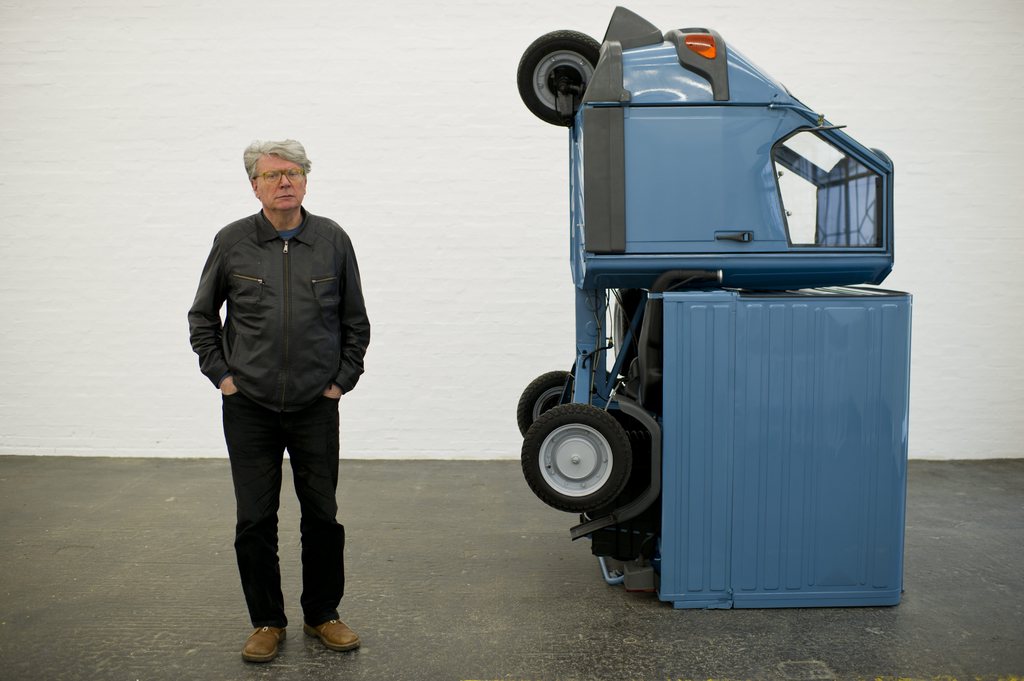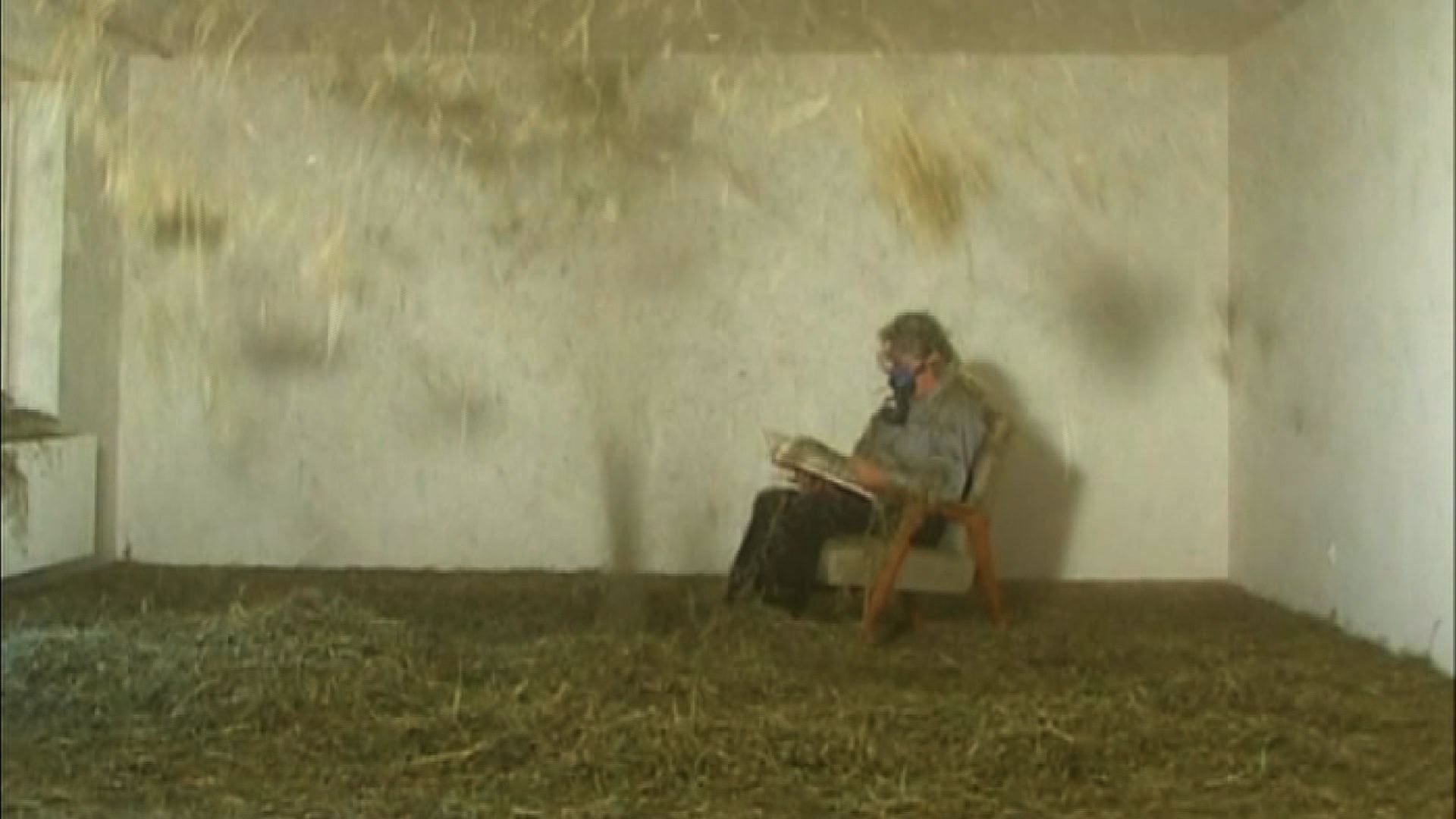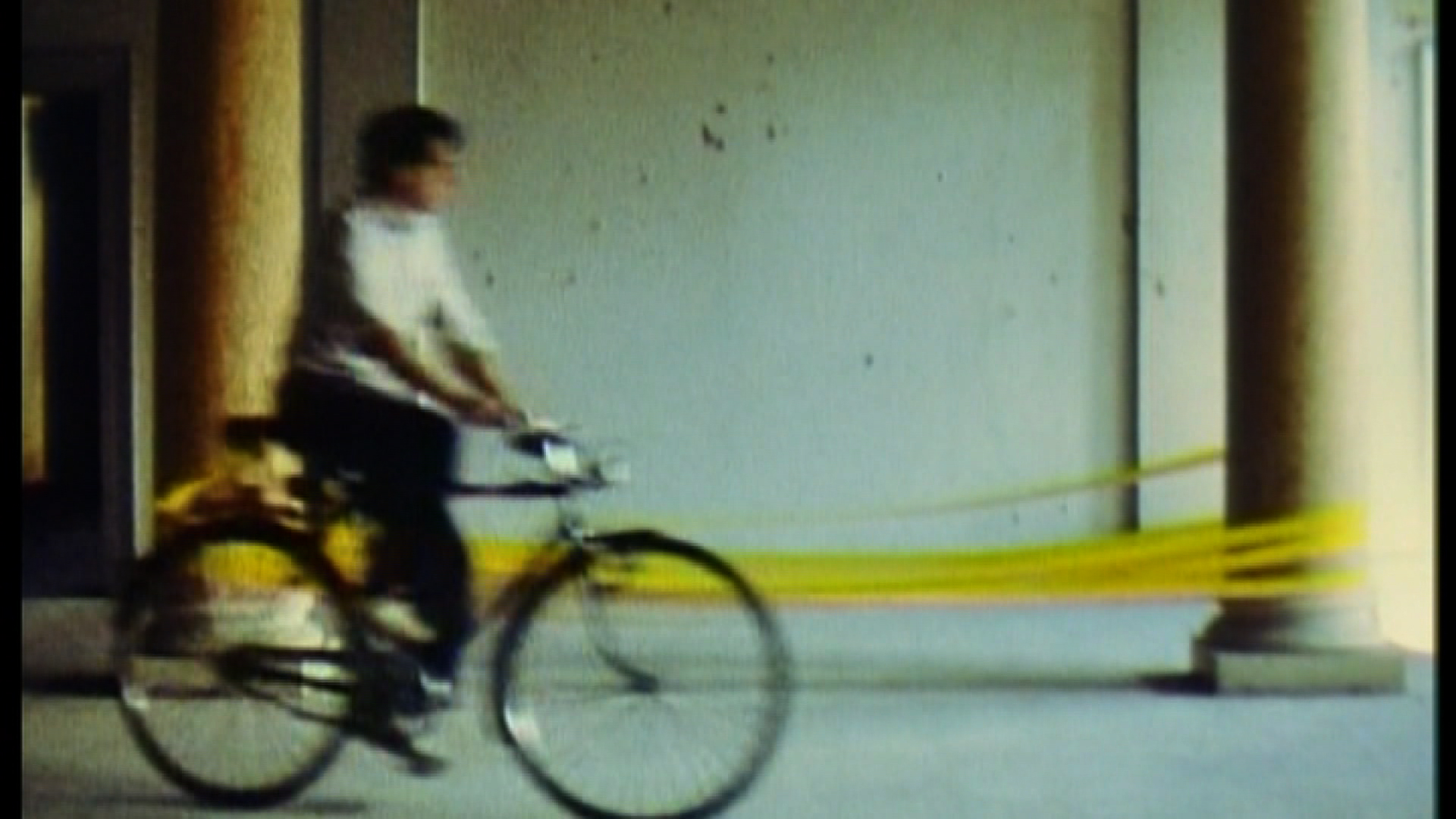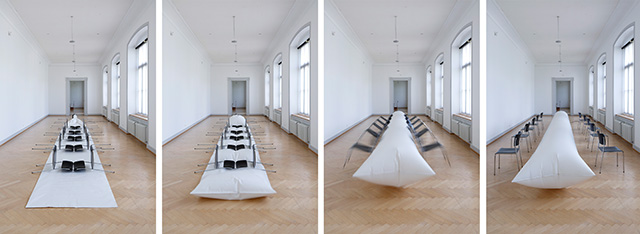
The subtle and moving art of Roman Signer

“I like it when something happens,” muses Roman Signer, whose films, sculptures and installations reveal a deliberate self-irony. Some of the Swiss artist’s most recent and dynamite works are now on show at the Kunstmuseum St Gallen.
The exhibitionExternal link launches with an amusing “takeoff”. Projected onto the staircase of the museum, the movie “Piaggio” shows Signer on a tricycle, complete with helmet and the artist’s usual oversized gloves.
This bizarre cosmonaut takes leave of his colleagues who proceed to tip the vehicle on its back. The pilot waves at the window, the countdown begins and… the tricycle disappears in a cloud of smoke.
A vehicle not really known for its rapidity transformed into a shotgun – such contrasts are the hallmark of the retrospective created by the St Gallen fine arts museum that holds several more surprises for its visitors.
Explosion without destruction
The exhibition, which runs until October 26, can be taken in quickly because it is comprised of just 16 works displayed in a handful of rooms. Speed and slowness being an integral part of these “temporal sculptures”, the rhythm of the exhibition is revealing of Signer’s workExternal link. But, like always, patience comes before the explosion! And explosions are what he is famous for.
But in a rare interview published in the “Tages-Anzeiger“ newspaper in June, Signer explained his dislike of being described as “an artist of explosions”. An explosion represents a rapid change, he says.
“One form becoming another does not always have to be destructive. The explosion contains numerous possibilities and aspects which are not yet exhausted.”
The artist – who became known through an installation in which stools were thrown through the window of the abandoned Kurhaus Weissbad hotel – continues to meld simple, even archaic objects with sophistication and expertise, a must when dealing with dynamite.

More
Some of Roman Signer’s ‘time-sculptures’
At the St Gallen exhibition, the installation “Chair With Hole”, created for a Swiss furniture brand, is the perfect example. Skilfully laid explosions blast a hole in the back of the chair. The explosion itself was filmed and is projected through the hole of the chair, creating a dizzying, self-referential piece.
It’s important to take the time to look at the entire process – any visitor who does is sure to have a smile on their face at the end.
Poetry and meditation
With this retrospective, the St Gallen-based Signer is reinvesting in the places where everything – or almost everything – began for him. In the early 1980s, he was able to use spaces in the museum that were closed to the public as a studio for an entire year.

More
Roman Signer’s works in his former atelier and now the art museum of St. Gallen
So the artist no doubt had little trouble figuring out where he wanted to place his works. For example, in an angled room, there are eight small blue metallic tables around which – apparently – nothing happens.
Not so; by lightly touching the table spotlighted by a projector at a particular moment, a wave is produced, followed by an exact reflection of that wave on the roof. The work was created especially for the museum and the poetic magic unique to Signer’s work provokes a meditative side.
‘My work is purely intuitive’
Elsewhere, it’s humour – also poetic – that dominates. One example is the hut in which the artist had himself sprayed with jets of paint and where traces of his motionless body are still visible, created for the Venice Bienniale in 1999. Another is the film of a globe – similar to one in the St Gallen library – filled with the colour blue and crashing in slow motion.
“My sculptures develop from events and experiences, they are not experimental and intellectual dispositions,” Signer told the “Tages-Anzeiger”. “My work is linked to my body, not with physics, as is often said… I don’t want to explain the laws of nature… My work is purely intuitive.”
How to raise the chairs
An installation in which overturned chairs are returned to their upright state by a large inflating air cushion is one of the few performances – done by a museum employee – that takes place in the exhibit itself. As the air is blown into the tube, a shadow of fear arises: what if the chairs fall on their sides? What if they spring back up too quickly and fall in the other direction? But on this particular day, everything happens as it should.

In another room, a destroyed bicycle shows the artist at work, even if the piece was completed long ago. Here, Signer exhibits the “objects of the crime” by placing in the centre of the room the saw that ended the bicycle’s life, as well as the protective glasses used by the “criminal” during the act itself.
Spectators can also re-enact the “crime”. Once cut up, the two parts of the bicycle, attached to rubber cables, were catapulted to either end of the room. Here the “corpses” lie, having lost all reason for existing.
An old projector
Other works project a similar element of melancholy. A pair of glasses, demonstrably those of the artist, lie on the floor under a metal plaque that crushes them; an old projector of the iconic Swiss brand Paillard-Bolex without film no longer projects a light beam in a barrel of water (taken from the artist’s work “Blue Barrel” at the Venice Bienniale). There, somewhat perplexingly, just a single blue mark appears.
Humour surfaces again with “Everything Goes Skiing”, a slogan that dates back to 1963 and the title of a song by popular Swiss-German artist Vico Torriani. Signer takes the slogan literally: a small mountain hut on skis has begun its descent just as the artist cuts the cable holding it.
A camera attached to the hut documents the ride and the footage is screened in the museum. Without moving an inch, the spectator can feel the hut sliding underfoot for several metres and wonders whether it will stay upright…
The senses of melancholy and of waiting transform into sadness when viewers see the chairs equipped with guns in one of the exhibition’s first rooms. Will they be fired or will the artist stop short? Signer also wants to show “the potential of things and situations,” so the waiting will continue, at least when it comes to this last piece.
Roman Signer was born in 1938 in Appenzell. He studied at the schools of fine art in Zurich (1966), Lucerne (1969-71) and Warsaw (1971-72). He has lived and worked in St Gallen since 1971.
During the 1970s, he made a name for himself with his “filmed protocols” and “actions”. In 1981, he told Swiss television about his attempts to create forms born from the interaction of “forces”.
“An explosion is not, for me, destruction, but a transformation,” he said, adding that he likes “the moment when we have the impression that things are weightless and suspended in air.”
For example, in “Boots” (1986), a beam of water gushes out in the shape of a person. The photo of that performance is perhaps one of the most popular postcards sold in Swiss museums.
Among his many other ideas, Signer has sunk a kayak, made hats take off like blasting guns, or manoeuvred miniature helicopters into narrow boxes and museum rooms. At the Venice Bienniale in 1999, he created “Gleichzeitig” (At the same time), an installation during which metal balls fall from the roof onto a clay base.
Seen at numerous festivals, the film “Signer Koffer”, a 1996 documentary by Peter Liechti, ensured that the already locally famous artist gained recognition around the world.
(Translated from French by Sophie Douez)

In compliance with the JTI standards
More: SWI swissinfo.ch certified by the Journalism Trust Initiative






























You can find an overview of ongoing debates with our journalists here . Please join us!
If you want to start a conversation about a topic raised in this article or want to report factual errors, email us at english@swissinfo.ch.